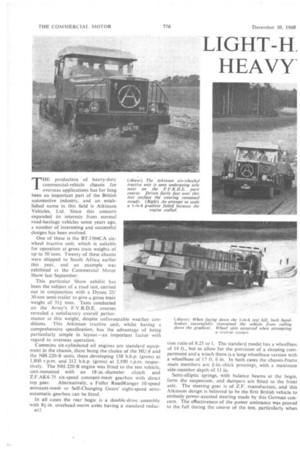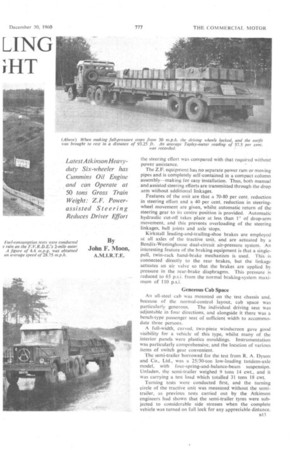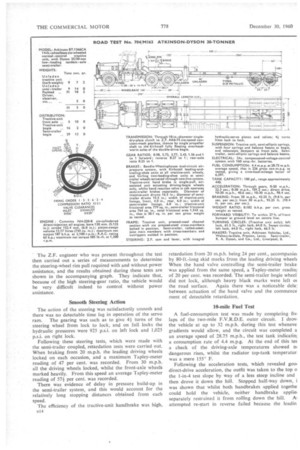LIGHT-H .
Page 46

Page 47

Page 48

Page 49

If you've noticed an error in this article please click here to report it so we can fix it.
HEAVY LING HT
Latest AtkinsonHeavyduty Six-wheeler has Cummins Oil Engine and can Operate at 50 tons Gross Train Weight: Z.F. Powerassisted Steering Reduces Driver Effort
By John F. Moon,
A.M.I.R.T.E. THE production of heavy-duty commercial-vehicle chassis for overseas applications has for long been an important part of the British automotive industry, and an established name in this field is Atkinson Vehicles, Ltd. Since this concern expanded its interests from normal road-haulage vehicles some years ago, a number of interesting and successful designs has been evolved.
One of these is the BT.1366CA sixwheel tractive unit, which is suitable for operation at gross train weights of up to 50 tons. Twenty of these chassis were shipped to South Africa earlier this year, and an example was exhibited at the Commercial Motor Show last September.
This particular Show exhibit has been the subject of a road test, carried out in conjunction with a Dyson 25/ 30-ton semi-trailer to give a gross train weight of 51+ tons. Tests conducted on the Army's F.V.R.D.E. courses revealed a satisfactory overall performance at this weight, despite unfavourable weather conditions. This Atkinson tractive unit, whilst having a comprehensive specification, has the advantage of being particularly simple in layout—an important factor with regard to overseas operation.
Cummins six-cylindered oil engines are standard equipment in the chassis, there being the choice of the HU.6 and the NH-220-B units, these :developing 158 b.h.p. (gross) at 1,800 r.p.m. and 212 b.h.p. (gross) at 2,100 r.p.m. respectively. The NH-220-B engine was fitted to the test vehicle, unit-mounted with an 18-in.-diameter clutch and Z.F.AK6-75 six-speed constant-mesh gearbox with direct top gear. Alternatively, a Fuller RoadRanger 10-speed constant-mesh or Self-Changing Gears' eight-speed semiautomatic gearbox can be fitted.
In all cases the rear bogie is a double-drive assembly with 8-f-in. overhead-worm axles having a standard reduca12 tion ratio of 8.25 to 1. The standard model has a wheelbase of 14 ft., but to allow for the provision of a sleeping compartment and a winch there is a long-wheelbase version with a wheelbase of 17 ft. 6 in. In both cases the chassis-frame main members are 1-in.-thick pressings, with a maximurr side-member depth of 11 in.
Semi-elliptic springs, with balance beams at the bogie, form the suspension, and dampers are fitted to the front axle. The steering gear is of Z.F. manufacture, and this Atkinson design is'believed to be the first 13ritish vehicle to embody power-assisted steering made by this German concern. The effectiveness of the power assistance was proved to the full during the course of the test, particularly when the steering effort was compared with that required without power assistance.
The Z.F. equipment has no separate power ram or moving pipes and is completely self-contained in a compact column assembly—making for easy installation. Thus, both manual and assisted steering efforts are transmitted through the drop arm without additional linkages.
Features of the unit are that a 70-80 per cent, reduction in steering effort and a 40 per cent. reduction in steeringwheel movement are given, whilst automatic return of the steering gear to its centre position is provided. Automatic hydraulic cut-off takes place at less than 10 of drop-arm movement, and this prevents overloading of the steering linkages, ball joints and axle stops.
Kirkstall leading-and-trailing-shoe brakes are employed at all axles of the tractive unit, and are actuated by a Bendix-Westinghouse dual-circuit air-pressure system. An interesting feature of the braking equipment is that a singlepull, twin-rack hand-brake mechanism is used. This is connected directly to the rear brakes, but the linkage actuates an air valve so that the brakes are applied by pressure in the rear-brake diaphragms. This pressure is reduced to 65 p.s.i. from the normal braking-system maximum of 110 p.s.i.
Generous Cab Space
An all-steel cab was mounted on the test chassis and, because of the normal-control layout, cab space was particularly generous. The individual driving seat was adjustable in four directions, and alongside it there was a bench-type passenger seat of sufficient width to accommodate three persons.
A full-width, curved, two-piece windscreen gave good visibility for a vehicle of this type, whilst many of the interior panels were plastics mouldings. Instrumentation was particularly comprehensive, and the location of various items of switch gear convenient.
The semi-trailer borrowed for the test from R. A. Dyson and Co., Ltd., was a 25/30-ton low-loading tandem-axle model, with four-spring-and-balance-beam suspension. Unladen, the semi-trailer weighed 9 tons 14 cwt., and it was carrying a test load which totalled 31 tons 18 cwt.
Turning tests were conducted first, and the turning circle of the tractive unit was measured without the semitrailer, as previous tests carried out by the Atkinson engineers had shown that the semi-trailer tyres were subjected to considerable side stresses when the complete vehicle was turned on full lock for any appreciable distance. The Z.F. engineer who was present throughout the test then carried out a series of measurements to determine the steering-wheel rim pull required with and without power assistance, and the results obtained during these tests are shown in the accompanying graph. They indicate that, because of the high steering-gear ratio, the vehicle would be very difficult indeed to control without power assistance.
Smooth Steering Action
The action of the steering was satisfactorily smooth and there was no detectable time lag in operation of the servo rain. The gearing was such as to give 41 turns of the steering wheel from lock to lock, and on full locks the hydraulic pressures were 925 p.s.i. on left lock and 1,025 p.s.i. on right lock.
Following these steering tests, which were made with the semi-trailer coupled, retardation tests were carried out. When braking from 20 m.p.h. the leading driving wheels locked on each occasion, and a maximum Tapley-meter reading of 47 per cent, was recorded. From 30 m.p.h. all the driving wheels locked, whilst the front-axle wheels marked heavily. From this speed an average Tapley-meter reading of 571 per cent. was recorded.
There was evidence of delay in pressure build-up in the semi-trailer system, and this would account for the relatively long stopping distances obtained from each speed.
The efficiency of the tractive-unit handbrake was high, 1314 retardation from 20 m.p.h. being 24 per cent., accompaniei by 80-ft.-long skid marks from the leading driving wheels When the hand valve controlling the semi-trailer brake was applied from the same speed, a Tapley-meter readirn of 20 per cent. was recorded. The semi-trailer bogie wheel did not lock, although heavy black marks were left of the road surface. Again there was a noticeable dela: between actuation of the hand valve and the commence ment of detectable retardation.
10-mile Fuel Test A fuel-consumption test was made by completing fiv, laps of the two-mile F.V.R.D.E. outer circuit. I drov, the vehicle at up to 32 m.p.h. during this test wheneve gradients would allow, and the circuit was completed a an average speed of 28.75 m.p.h., the test tank indicatini a consumption rate of 4.4 m.p.g. At the end of this tes a check of the driving-axle temperatures showed Ili dangerous rises, whilst the radiator top-tank temperatur was a mere 155° F.
Following the acceleration tests, which revealed goo' direct-drive acceleration, the outfit was taken to the top o the l-in-4 test slope by way of a less steep incline and then drove it down the hill. Stopped half-way down, i was shown that whilst both handbrakes applied togethe could hold the vehicle, neither handbrake applie• separately restrained it from rolling down the hill. Ai attempted re-start in reverse failed because the leadin driving wheels slipped, and when the air-operated differential lock was engaged both sets of driving wheels The vehicle was then turned round at the bottom of the slope and an attempt made to ascend the gradient in bottom gear, but the engine stalled half-way up the slope and at this point only the footbrake would hold it, the combined effect of both handbrakes being Jnequal to the task of preventing rearward motion.
Smooth bo t to mand -everse-gear restarts on a
1 in 10.45 gradient were then carried out, and facing both up and down this slope either handbrake was powerful enough to hold the outfit. Optimistic attempts at restarting in second gear were almost successful, but the engine power was not quite sufficient to continue forward motion.
The semi-trailer was then disconnected and the solo
tractive unit was driven fairly fast over the pavd and 1+-in.
block suspension courses. Over the pavd the ride was somewhat rough but the steering remained steady because of the power assistance, whilst over the 11-in. blocks it was quite easy to keep the vehicle on a relatively straight line despite rather severe shaking.
. –.—...
assistance
Wth hydnaulk assistitnce . not workin§ ' presaire Hydraulic Hydrau'lic
workinsr_l_
r / 11
1
;
– -
/ /
Taken generally the Atkinson handled well. The engine pulled well, and the amount of noise penetrating the cab was reasonably low. Clutch actuation was on the heavy side, but the brakes had good feel characteristics. The cab was comfortable to ride in, but vision directly ahead was somewhat limited because of the long, high bonnet.
Excessive gear-lever travel noted on the test
. z model as now been eliminated.




























































































